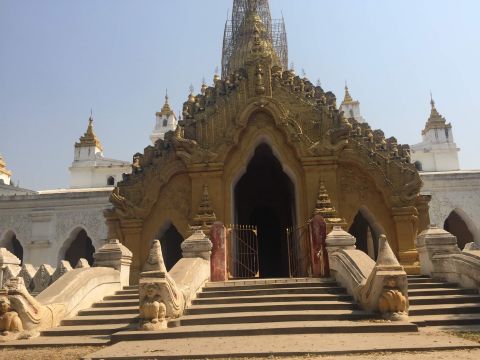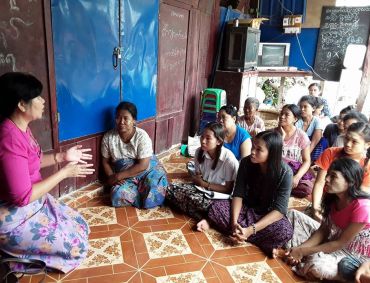A Shared Locale: Changing Pedagogy in Cultural Anthropology and Sociology, University of Mandalay (3)
Another female MA student is Ms. Myo Thandar Soe and she began the introduction of cultural anthropology in her presentation.
“Cultural anthropologists specialize in the study of culture and peoples’ beliefs, practices, and the cognitive and social organization of human groups. Cultural anthropologists study how people who share a common cultural system organize and shape the physical and social world around them, and are in turn shaped by those ideas, behaviors, and physical environments.”
She continues:
“Our group visited to Kyautawgyi Pagoda in Taungthaman Village. Meanwhile, I observed most Buddhists who came to the pagoda view pagodas as a sacred place to pray and worship, especially for the middle and older ages. But for now, most of the university students view the pagoda not only as a place to worship, but also as a place to take a rest, to study and for the couples as a dating place.
In this paragraph, she pointed out a specific “place” as Kyauktawgyi but she identified how younger generation and older generation to view the Kyauktawgyi pagoda and she also use the concept word “sacred place”. Normally, most could not use concept codes in their MA thesis and term papers but here she understood what kinds of concept words are suitable to use in the Kyauktawgyi pagoda. This made me to satisfy their conceptualization connected with local field trips.
She said: “When we arrived there we firstly noticed young couples who are behaving inappropriately at the platform around the pagoda, like lying on the lap of the girlfriend, kissing each other and hugging tightly each other. For me as a student and also as a youth, I think these behaviors should not be able to allow to them in this pagoda space and I feel a bit weird. In my view, most of them are Buddhists and they should internalize the pagoda as a sacred place and they should not behave like that.”
In this paragraph, she can add her perception on youths in the way how they should consider in this pagoda compound. This is the students’ own critical concepts openly regarding the sacred space. Most students like this kind of critical thinking to sit in the exam because they don’t like to read lectures by heard. By this kind of pedagogy, I hope the students thinking can be extended more than before.
She also continued: “There are also students reading by heard lessons that they learned in the class. The nearer the exam, the more students come to the pagoda to study. They see the pagoda as a place to study because the Kyauktawgyi pagoda compound is cool inside and a quiet place. But when they have their exams, they sometimes worship and pray at the pagoda. There are also groups of people who were eating, talking and sometimes playing UNO. For them, the pagoda is a place where they meet friends and play games. There are children and old people who ask for money observed. For them, the pagoda is a market for their income and for the vendors also. There are also local and foreign visitors. For them, the pagoda is a place to worship and to observe the wall paintings and ancient technique of buildings. So, to the single place of Kyout-Taw-Gyi Pagoda, many people have different values and perceptions, and they come to this pagoda and use it with different intentions.”
Finally she concluded: “From cultural anthropological point of view, we can conclude that, people can have different values and different perceptions on the same place. People's views, values, perceptions and opinions of a place are influenced by many factors such as gender, age, cultural background, time (of day/ week/ year) and distance from other places. We must understand that our own culture and life experiences shape the way we perceive places. Perceptions are the basis for understanding a place’s location, extent, characteristics, and significance. Throughout our lives, culture and experience shape our worldviews, which in turn influence our perceptions of places.”
Because of the combination of classroom and field work as practical experiences, I noticed that the students could think about a “Place” where they went from different points of view and conclude their concepts with field codes by analyzing their writing style.
Myanmar (Burma)


